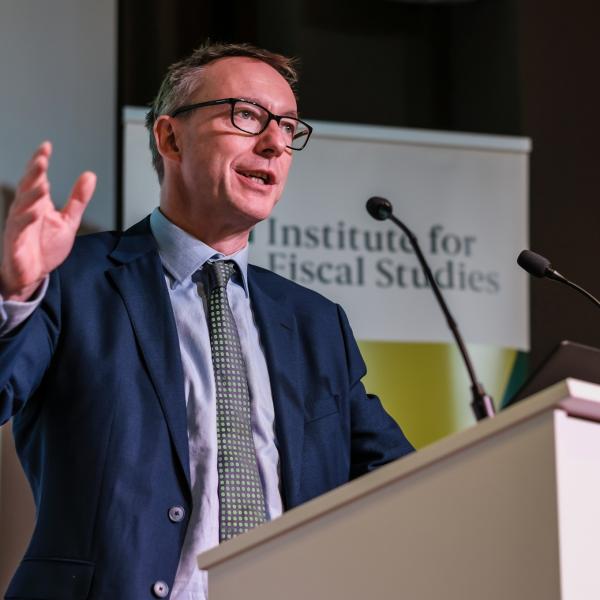We recommend watching the event on Slido by clicking here, where you can also ask questions to the panel.
Ten days before polling day, IFS researchers and Director Paul Johnson will give their verdict on the parties' manifestos - in particular comparing the offering from the Conservative Party with that from the Labour Party - at a press briefing in Westminster. At this event, which will be live-streamed for the general public, we will present new analysis on how manifesto policies could impact the public finances and what they might mean for household incomes, public services and taxation.
There will also be the opportunity after the presentations for you to put your questions to our panel.
You can find the slides for the presentations here.
Opening remarks by Paul Johnson, Director, Institute for Fiscal Studies
Manifestos leave voters guessing over policy on tax and spending, and on future size and shape of state
Debt is at its highest level in more than 60 years. Taxes are at near enough the highest ever level seen in the UK. They have risen more over this parliament than over any other since the second world war. Spending has also risen: the fourth largest increase per year in public spending as a share of national income, and biggest under a Conservative government.
Yet public services are visibly struggling. Despite these high tax levels, spending on many public services will likely need to be cut over the next five years if government debt is not to ratchet ever upwards or unless taxes are increased further.
How can that be? A £50 billion a year increase in debt interest spending relative to forecasts and a growing welfare budget bear much of the responsibility. Then we have rising health spending, a defence budget which for the first time in decades will likely grow rather than shrink, and the reality of demographic change and the need to transition to net zero. Add in low growth and the after-effects of the pandemic and energy price crisis and you have a toxic mix indeed when it comes to the public finances.
These raw facts are largely ignored by the two main parties in their manifestos. That huge decisions over the size and shape of the state will need to be taken, that those decisions will, in all likelihood, mean either higher taxes or worse public services, you would not guess from reading their prospectuses or listening to their promises. They have singularly failed even to acknowledge some of the most important issues and choices to have faced us for a very long time. As the population ages these choices will become harder, not easier. We cannot wish them away.
Low growth, high debt and high interest payments mean we need to do something quite rare just to stop debt spiralling ever upwards: we need to run primary surpluses. That means the government collecting more in tax and other revenues than it spends on everything apart from debt interest. Not necessarily a recipe for a happy electorate.
A fiscal target which implies debt falling in five years’ time, as both the Conservatives and Labour have committed to, is looser than any debt target we have had since 2008. Yet it will constrain. Taking it seriously – and this is one thing both manifestos do appear to take seriously – will mean painful choices. None of which are faced up to.
Current plans are for big real-terms cuts to investment spending – of £18 billion a year by 2030. While the March Budget assumes overall day-to-day spending will rise by 1% a year above inflation, plausible settlements for the NHS, childcare, and defence, will likely leave other services facing cuts of somewhere between £10 and £20 billion a year.
The “conspiracy of silence” about all of this has been maintained. Regardless of who takes office following the general election, they will – unless they get lucky – soon face a stark choice. Raise taxes by more than they have told us in their manifesto. Or implement cuts to some areas of spending. Or borrow more and be content for debt to rise for longer. That is the trilemma. What will they choose? The manifestos have left us guessing.
So in these opening remarks I am simply not going to engage with these so-called "fully costed" manifestos on their own terms. Their proposals on tax, benefits and public service spending would be barely enough to detain us in analysing a modest one-year fiscal event. They certainly don’t answer the big questions facing us over a five-year parliament.
Tax and spending
In line with their unwillingness to face up to the real challenges, neither main party makes any serious new proposals to increase taxes. Consistent with their conspiracy of silence, both are keeping entirely silent about their commitment to a £10 billion a year tax rise through a further three years of freezes to personal tax allowances and thresholds.
Tax rises, such as they are, are all about increasing taxes invisibly, on other people. Almost all parties are quite confident they can raise £5 billion or more from “cracking down” on tax evasion and avoidance. Maybe. None makes much of the fact that on official estimates most of the shortfall in what HMRC collects is not from big, faceless conglomerates, but from the self-employed and small businesses.
The Conservatives offer a further cut to the rates of employee and self-employed NICs. Their other two proposals on personal tax - increasing the income tax allowance for pensioners and reforming the HICBC – are yet more reversals to policies implemented by Conservative chancellors since 2010.
Labour set out a handful of tax-raising measures that, in aggregate, are small. For some non-doms working in private equity, receiving income in the form of carried interest, sending their children to an expensive private school, and bequeathing them an offshore trust, the increase in tax will be large. But there are very few such people so the overall amount of money available is small.
None of that is a prediction as to what will happen. Despite a (damaging) rush to rule out increases in all sorts of tax rates, it will be a considerable surprise if no other taxes are increased over the next five years. After all, they are currently much higher than was implied by the 2019 Conservative Party manifesto.
Indeed, the manifestos told us much more about what they wouldn’t do than what they would. Tax locks - pledges not to increase specific taxes or tax rates - aren’t new. But this time, the parties have really gone to town. We’ve seen something of a tax lock arms race. Both have tied their hands on income tax, NICs, VAT and corporation tax. The Conservatives have a long list of other tax rises, and reforms, that they wouldn’t do. Labour have ruled out more tax options since the publication of the manifestos.
Taken at face value, Labour’s promise of “no tax increases on working people” rules out essentially all tax rises. There is no tax paid exclusively by those who don’t work. Who knows what this pledge is really supposed to mean.
These tax locks are a mistake. They will constrain policy if a future government decides that it does in fact want to raise more money to fund public services. They also put serious constraints on tax reform – something which the Conservatives seem to have all but ruled out, and which is notable in the Labour manifesto by its absence.
On the spending side, Labour’s additional day-to-day spending commitments are essentially trivial. They offer nothing concrete on welfare. They do plan to boost green investment by an average of £5 billion a year. Given that spending on green investments is currently only around £8 billion a year, this is a major pledge, even if much watered down. But it would still leave public sector net investment falling under a Labour Government.
The Conservatives claim they would cut spending on working-age benefits by £12 billion a year, largely by slowing the dramatic growth in claims for disability benefits. Given the extraordinary rise in claims and spending in recent years any government is bound to want to focus on this – though the Labour manifesto says little on the issue. At the time of the last election there were 2 million working-age individuals in England and Wales receiving disability benefits. That is forecast to reach 3 million this year, and to climb to 4 million in 2028–29. Even so, cutting £12 billion from expected spending in 2029-30 would be seriously tough.
Promises to deliver much-needed improvements to the NHS are essentially unfunded commitments. Both parties want to reverse nearly a decade of rising waiting times. Both reaffirm their commitment to the NHS England workforce plan. Build more hospitals. Expand mental health services. The list goes on. These “fully costed” manifestos appear to imply all this can be delivered for free. It can’t. You can’t pledge to end all waits of more than 18 weeks, allocate no money to that pledge, and then claim to have a fully costed manifesto.
How would either party deal with backlogs in the court system, overflowing prisons, crises in funding of higher and further education, social care, local government? We have not a clue.
Labour is proposing no change to spending on social security benefits or state pensions. The two-child limit – which will affect an additional two thirds of a million children by 2029 – is due to remain. But stop. Labour has committed to reviewing universal credit and to develop a strategy to reduce child poverty. Might those conclude that, after all, a more generous working-age benefit system would have to play a part in lifting children out of poverty in the next parliament? Maybe. If it does, how would that be funded?
Labour’s manifesto is chock full of reviews and strategies. It contains a detailed diagnosis of ‘the problem’ in many areas, and a welcome recognition that many of these issues are interrelated. For example, child poverty bleeds into pressures on mental health, on schools, on homelessness. All good. But no sense of what it will do when it finds it needs more resources to deal with these issues.
Other parties available
No other party is in contention for office, but their manifestos matter, in part because they help set the tone of the debate.
The Liberal Democrats have bigger tax and spend policies than Labour and Conservatives, wanting to raise taxes by £27 billion to fund a £4 billion boost to the working-age benefit system and a £23 billion boost to day-to-day public service spending. They would increase investment spending, to the tune of £20 billion a year. Their tax rises would come largely from a combination of reducing avoidance, increasing capital gains tax, taxing banks, taxing flying, and taxing energy companies and technology giants, though their proposed measures would be unlikely to bring in all the revenue they seek.
There are some good ideas here, and some less good ones. But these would not be ‘victimless’ taxes. Tax is near a record high as a fraction of national income. But direct taxes on average earners are historically low. We raise far more from corporation tax and those on high incomes than we have ever done before. Not all large tax rises will only and always hit just these unworthy victims, and ones that do can also risk economic damage.
Reform UK and the Greens offer much bigger numbers still. The policies they outline are not going to be implemented. But the way they suggest that they have radical ideas which can realistically make a positive difference, when in fact what they propose is wholly unattainable, helps to poison the entire political debate.
Take Reform. They propose £90 billion of specific tax cuts and £50 billion of spending increases, "paid for" by a £150 billion package of measures that includes substantial, unspecified cuts in welfare and government waste. If they want a smaller state – a perfectly reasonable ambition – they should tell us how they will achieve it. We saw the consequences of massive tax cuts with no detail on how they would be paid for in September 2022.
In any case, the claim that they could eliminate NHS waiting lists at a cost of £17 billion a year is demonstrably wrong, while the vast tax cuts would cost even more than stated, by a margin of tens of billions of pounds per year.
On the other side, the Green Party set out a vision for a much larger state. They propose a set of tax-raising measures which they claim would allow them to spend far more on public services. The most scrutinised of these is a wealth tax - but this is in fact only a small element of how they say they would pay for additional spending. A large part is an additional £80 billion a year of borrowing, to be constrained only by its effect on inflation. A massive increase in borrowing when the economy is capacity-constrained, and the debt interest burden is already just that, a huge burden, would have unpleasant consequences.
Their biggest proposal is for a £90 billion a year carbon tax. Tax is a good lever to use to help achieve emissions reductions. A substantially higher tax would incentivise a faster transition to net zero. It would also have far-reaching economic implications. Any attempt to levy a carbon tax at that rate would have a fundamental effect on our economy. That of course is the point. But it would not be painless. It would raise the cost of many essentials and be economically disruptive. Much, probably most, of any money raised, would need to be used to mitigate those effects, and to support those on lower incomes, not to fund other things. In any case, any effective carbon tax would reduce the amount of carbon-based activity and hence, eventually, raise a lot less.
Ambitions for economic growth
Here there are differences between the parties. The Conservative Party manifesto, broadly speaking, puts its faith in cuts to taxes, regulations and red tape. To the extent that there are new plans, they are largely about getting the government out of the way.
The Labour Party manifesto claims growth as its central mission. One of the flagship policies is to liberalise planning laws. I bow to nobody in my keenness to overhaul our costly and sclerotic planning regime. It will be technically difficult and politically painful. All power to their elbow on this one.
On the broader set of policies, the mood music suggests a belief that the state can fix things - an ‘active’, ‘mission-led’ government that makes ‘strategic’ investments and uses regulation, competition policies and industrial strategies to drive growth. A focus on green growth and money for net zero investment. But remember, there is a choice here. If you had £5 billion a year to put into the most growth-friendly policy, it is unlikely that green investment is what you’d choose. This might or might not be the right priority, but it is not the same priority as growth.
I am an optimist about the capacity of good policy to drive growth. The UK needs effective public investment, more private investment, planning reform, tax reform, removal of barriers to trade - notably non-tariff barriers with our nearest and richest neighbour, the European Union - and education and training policies to deliver a workforce with the right skills.
But some words of caution. Effects will be uncertain and take a long time to arrive. Difficult decisions will be required. There are nearly always trade-offs, winners and losers – one reason why planning reform has proved so hard. Ignoring tax reform and ruling out rejoining the customs union already suggests some pro-growth policies are beyond the pale.
Even much stronger growth – either as a result of policy or of luck – isn’t a get out of gaol free card. Suppose the next government gets really lucky and growth is (forecast to be) half a per cent a year more than the OBR’s relatively optimistic March forecast. That is not impossible. But even that would do little more than allow the new government to avoid cuts to spending that are currently pencilled in. It would not create a spending bonanza of any kind.
If better growth materialises in the next parliament - and it might - that will be largely due to good luck. We should hope it happens. But hoping for the best is not a strategy. If, instead, the OBR’s views were to move in an unhelpful direction, for example towards those held by interest rate setters over at the Bank of England, then the fiscal trilemma could suddenly look even worse.
A key question to ask of those seeking our votes on July 4th is how would they respond to such bad economic news. Put taxes up by more? Deepen those cuts to spending? Or push back the date at which debt is forecast to fall? We have not been told. And a clear lesson of the last Parliament is that bad shocks do happen. Is it so unreasonable for us to be given a hint of how they would prioritise before polling day?
Conclusions
We need more efficient and effective public services. We need a government laser-focused on improving our economic performance. It’s good to see those facts acknowledged. But on the big issues over which governments have direct control - on how they will change tax, welfare, public spending - the manifestos of the main parties provide thin gruel indeed. On 4 July we will be voting in a knowledge vacuum.
If - as is likely - growth forecasts are not revised up this autumn, we do not know whether the new government would stick roughly to the day-to-day and investment spending totals set out in the March Budget, or whether they would borrow more or tax more to top them up. If they were to stick to spending plans we do not know what would be cut. If taxes are to go up, we do not know which ones. We certainly don’t know how they would respond if things were to get worse.
The choices in front of us are hard. High taxes, high debt, struggling public services, make them so. Pressures from health, defence, welfare, ageing will not make them easier. That is not a reason to hide the choices or to duck them. Quite the reverse. Yet hidden and ducked they have been.











